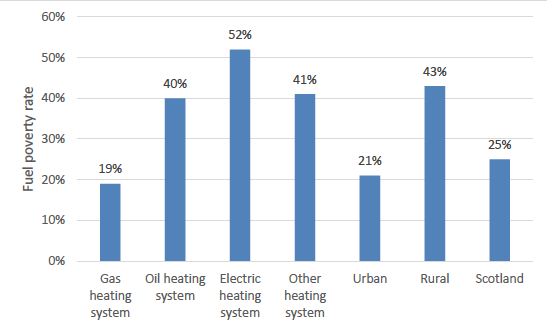Energy Efficient Scotland: the future of low carbon heat for off gas buildings - call for evidence
We are seeking evidence on technologies and actions necessary to support the decarbonisation of the heat supply of buildings that currently do not use mains gas as their primary heating fuel.
Low Carbon Heat and Fuel Poverty
Overall, all households that do not use mains gas are more likely to be in fuel poverty. In 2017, 52% of those using electric heating systems and 40% of those using oil were in fuel poverty, compared to 19% of households connected to the gas network. (Figure 4). For properties using electricity for heat the high levels of fuel poverty are connected to the high unit cost of electricity, while for oil users it is likely connected to the nature of the rural housing stock with more detached dwellings with poor energy performance[55].
Figure 4 : Fuel poverty rate by primary heating system
There is a risk that replacing high carbon heating systems with low carbon equivalents could increase the fuel poverty rate. The upfront cost of low carbon heating systems are often higher than the existing high carbon alternatives. The running costs of low carbon systems can, however, be comparable to (or lower than) those of high carbon or existing electric systems. It is important to improve the energy efficiency of buildings before or at the same time as installing low carbon heat to help reduce the overall demand for energy to provide a sustainable, long-term reduction in fuel bills.
We are interested in your views on how the off gas heat supply can be decarbonised while also lifting households out of fuel poverty.
Questions
40. What examples can you provide of instances where installing a modern low carbon heating systems has also lifted households out of fuel poverty?
Contact
Email: lowcarbonfuture@gov.scot
There is a problem
Thanks for your feedback
